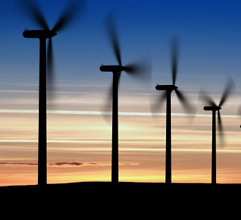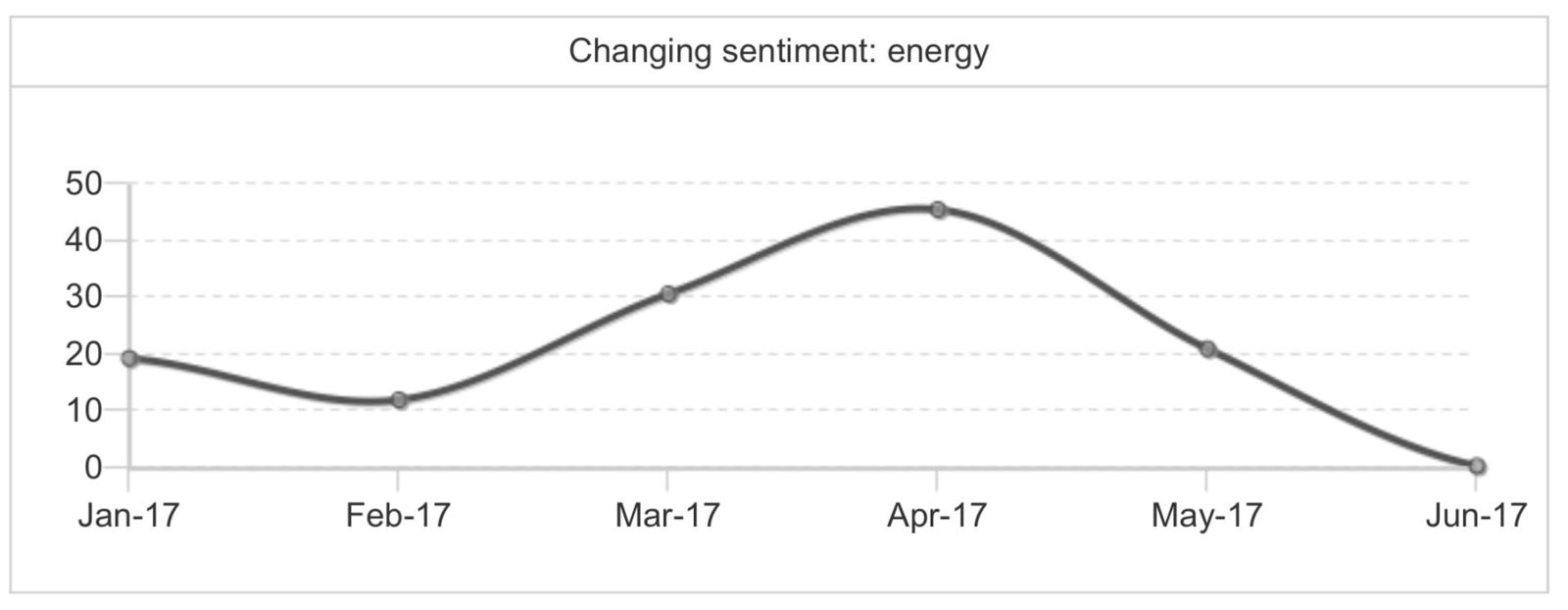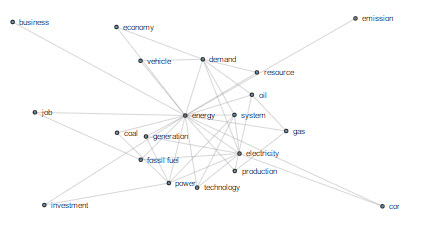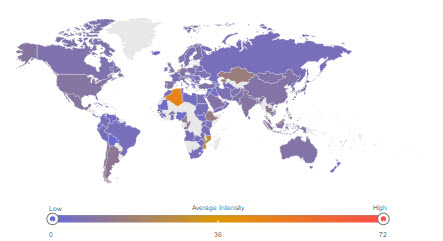
By 2025, solar will be the cheapest energy globally. In 2040, oil and natural gas are expected to make up nearly 60% of global supplies, while nuclear and renewables will be approaching 25%. Improved efficiency of lighting and home appliances is expected to continue to reduce residential electricity usage. Coal will fall out of favour.
- Pursuing Global Goals opportunities in energy and materials could create 54 million jobs.
- In China, wind and solar will contribute 35 percent of energy generated in 2040.
- Continued uncertainty over climate regulation affects capex in energy and creates stranded asset risk - over US$300 billion of assets could be affected.
- The Business and Sustainable Development Commission has previously identified US$12 trillion in annual business opportunities that will open up for the private sector if it delivers the Global Goals in four systems: food and agriculture; cities; energy and materials; and health and well-being.
- Wind and solar will account for 35 percent of energy generated in China in 2040.
- The world's first solar-powered bike path is generating more energy than expected.
- A network of batteries that will store energy generated from the sun has the potential to "revolutionize" the U.S. low-carbon grid.
- Less intensive use of energy and increased efficiency could potentially raise energy productivity in the global economy by 40% -70% by 2035 and unlock trillions of dollars in savings for global consumers of resources.
- The UK could become energy self-sufficient in renewable energy.
- Trump withdrawing the US from the Paris Climate Change Accord will increase the need and market for technology that can create clean energy.
- National and sub-national programs that foster clean energy are expected to continue regardless of global goals and the U.S.'s withdrawal from the Paris Agreement.
- China, India and many other countries are pushing forward to grab a share of the economic opportunity that lies in clean energy.
- Geothermal and bio energy will remain the backbone of heating supply for the coming decades.
- Nuclear energy accounts for a fifth of UK electricity generation and several new reactors such as at Hinkley Point are planned but Brexit could disrupt access to fuel and technology.
- Energy companies stand to gain US$300 billion from the expansion of renewable energy in Asia Pacific, a region where energy demand is expected to almost double by 2030.
- Continued regulatory support for renewable energy in key markets will see global power investment reach $443.5 billion in 2017.
- Investments into renewable energy and energy efficiency could bolster the global economy by US$19 trillion by 2050.
- By 2030, shifting energy and materials systems onto sustainable pathways could generate business opportunities in Asia worth US$1.9 trillion.
- Solar energy could provide 14% of U.S. electricity demand by 2030 and 27% by 2050.
- South Australia will install an enormous solar power system together with enormous batteries it can use solar energy at night.
- The global market for energy efficient building technologies is expected to reach $227.4 billion in 2017 and grow to nearly $360.6 billion in 2026.
- The U.S. move will serve to put China in the position to lead the commercialization of new energy vehicle technologies.
- Solar power is projected to be the least-expensive electricity technology in most of the world by 2030.
- China and India could cut current building energy consumption by 25 percent through cost-effective improvements in energy efficiency.
- Energy-saving initiatives in less energy-intensive industries could reduce final energy consumption by more than 3 percent in 2030.
- Analysts agree that the share of liquid hydrocarbons in global energy consumption will slightly decrease but exceed 25-28 percent in future.
- China will need to increase wind and solar power's share of primary energy consumption to 17 percent by 2030 if it is to meet its climate pledges.
- Biodiesel consumption in the EU will not expand drastically as regulators are focusing on the adoption of unconventional biofuels with lower greenhouse gases emissions and not at increasing the compulsory blending mandates.
- Regulators' increasing interest in reducing the more than US$400 billion in fossil fuel subsidies worldwide could significantly reduce demand by increasing end-user prices.
- The current total energy demand from China or Europe could be supplied 2.5 times over.
- Energy companies stand to gain US$300 billion from the expansion of renewable energy in Asia Pacific, a region where energy demand is expected to almost double by 2030.
- The Association of Southeast Asian Nations forecasts an increase in members' energy demand of 80 percent through to 2035.
- Solar energy could provide 14% of U.S. electricity demand by 2030 and 27% by 2050.
- Eventually U.S. business will be operating at a higher cost than competitors around the world that rely on clean sources.
- By 2040 the prices of fossil energy sources will have risen drastically in response to increasing scarcity. [Uncertainty! – We recommend creating scenarios here. Contact us to learn how]
- By 2040 the prices of fossil energy sources will be at a low level following a prolonged period of oversupply. [Uncertainty! – We recommend creating scenarios here. Contact us to learn how]
- The demise of coal as a power source in the U.S. is going to continue regardless of the Paris agreement.
- Negative effects from climate change could total $44 trillion if the United States fails to shift to more renewable energy sources.
- China and India could cut current building energy consumption by 25 percent through cost-effective improvements in energy efficiency.
- Investments into renewable energy and energy efficiency could bolster the global economy by US$19 trillion by 2050.
- Greater energy efficiency is another major objective of the Global Goals that will lead to process changes across traditionally energy-intensive industries (such as steel and cement) as well as less energy-intensive sectors.
- Less intensive use of energy and increased efficiency could potentially raise energy productivity in the global economy by 40% -70% by 2035 and unlock trillions of dollars in savings for global consumers of resources.
- Energy storage capacity in emerging markets worldwide is expected to grow by more than 40 percent annually in the coming decade.
- A total of 200 megawatts of wind and solar energy generation capacity will be installed at the 12 Indian government-owned ports by 2019.
- The IEA's 2005 version of the World Energy Outlook projected the total capacity of wind in 2030 at 375 GW.
- Coal is expected to make up 60 percent of China's energy mix in 2017.
- Helping smaller economy countries in Africa, Latin America, and Asia grow through through a cleaner energy mix will reduce emissions and limit global warming while pushing richer countries to curb their own emissions.
- Singapore's plans to introduce a carbon tax from 2019 will nudge companies to reduce emissions.
- Companies that did not have the foresight to start assessing the digital transformation years ago will be at a serious disadvantage competing in the years to come.
- Donald Trump's decision to leave the Paris Accord on climate change could spark increased drilling and production rates from American oil companies.
- Energy companies stand to gain US$300 billion from the expansion of renewable energy in Asia Pacific, a region where energy demand is expected to almost double by 2030.
- China will eventually allow private companies to invest in the country's oil and gas storage.
- There appears to be no common view on the role that renewables will play in 2050 amongst experts from the conventional and renewables industries, the scientific community and policy makers.
- Energy experts expected the renewable energy industry to grow to at least the size of the current global automotive industry over the coming decades.
- Energy-saving initiatives in less energy-intensive industries could reduce final energy consumption by more than 3 percent in 2030.
- Greater energy efficiency is another major objective of the Global Goals that will lead to process changes across traditionally energy-intensive industries (such as steel and cement) as well as less energy-intensive sectors.
- The global renewable industry will reach the size of the global car industry by the middle of this century.
- The United States chooses to hold back its own emerging renewables industry and will impede job growth in the future.
Sentiment Analysis
Energy has been sentiment neutral over the past six months apart from a positive blip in May. But that masks a series of positive technological (smart cities, driverless cars etc.), netted against several threats including demand and supply changes, alternative fuels and geo-political issues.

Topic map
We recommend you further explore these topics forecasts at Shaping Tomorrow to gain further foresight on how energy may be impacted in the future particularly in how driverless cars and self-geneartion will impact on energy demands.

Heat map
Almost all the populated world faces future energy challenges, even in Africa where opportunities for renewables abound.

Graphit
By 2020 the energy industry could be seriously affected by supply and demand issues which could take the price of oil down to $25 per barrel due to higher efficiency. What would be the impact on you and your business if this occurred?

Athena: Our robot, has determined which forecasts should be included in this Trend Alert. She found 13, 463 forecasts in seconds to allow us to publish this summary in less than thirty minutes. She can turn these into PowerPoint slides and Audio files in minutes too as you wish.
Athena does show duplicates to aid your understanding of themes as well as contradictory forecasts. She may also show near-duplicates. You can speed read past the duplicates and near-duplicates if you wish, though the latter may show additional information. You can use the contradictory, and likely uncertain forecasts she finds to imagine different scenarios. The future is unpredictable but we can examine the possibilities and choose our preferable future from the choices she presents.
Keep up to date
You can stay bang up to date on this topic or choose from our many automatic reports to determine what’s next in seconds.
Social changes | Sector prospects | Risks & opportunities | Year-by year | G20 watch | Key Organizations
You can also ask us to set-up private topics for you (clients only) to achieve the same thing as this Trend Alert for your associates or set up Email subscriptions (Registration required) on your favourite subjects.